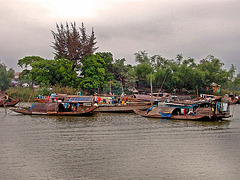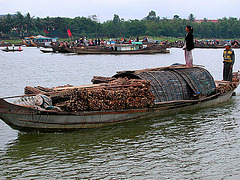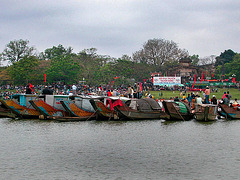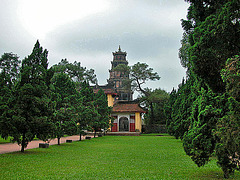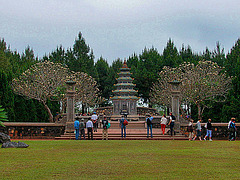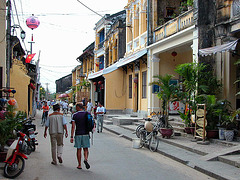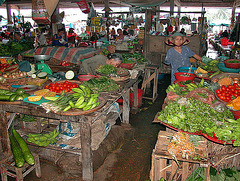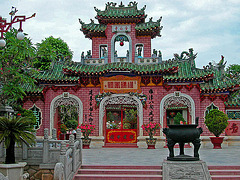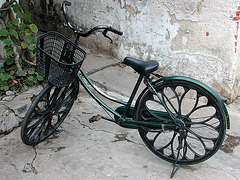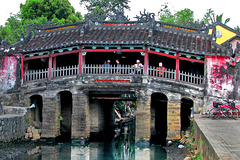
Vietnamese memories
Many of my friends ask me to transfer my Flickr album to IPERNITY - here is done - and I added some pictures more:
Vietnam or Việt Nam is the country of the Viets, the majority ethnic group in Vietnam. "Nam" means "the South", affirming Vietnam's sovereignty from China (usually called "North country" by the Vietnamese).
It was our first visit in March 2003 and honestly spoken out we had a bid of …
(read more)
The dwellers on the Hương River
| |
|
|
|
The locals who live on and beside the river in Huế are often very poor and wash their clothes and taking bath in the polluted water.
Along the Huong River (Perfume River)
| |
|
|
|
Huong River also called Perfume River is a main waterway in Vietnam.
A river that crosses the city of Hue, in the central Vietnamese province of Thua Thien-Hue Province.
In the autumn, flowers from orchards upriver from Hue fall into the water, giving the river a perfume-like aroma, hence the sobriquet.
A boat trip on the Perfume river (Hương River)
| |
|
|
In the autumn, flowers from orchards upriver from Huế fall into the water, giving the river a perfume-like aroma.
Simple barge transport
| |
|
|
|
Perfume or Huong River is around 80 kilometers long, and owes its name to the fact that it flows through many forests of aromatic plants before reaching Hue, bringing with it a pure and fresh aroma. Its an important waterway for many simple transport barges.
Regatta on the Hương River
| |
|
|
During our boat trip on the Perfume river (Huong river) we passed event of a regatta called Hội đua thuyền rồng a rowing boat competition. Many onlookers came with their barges.
In the park behind the Thiên Mụ Pagoda
| |
|
|
The temple complex stretches north from the river banks in seven successive tiers, each of which is dedicated to a human form taken by the Buddha or a step to enlightenment (depending on whom you ask).
Thiên Mụ Pagoda
| |
|
|
The Thiên Mụ Pagoda has its roots in a local legend: an old woman once appeared on the hill and said that a Lord would come and build a Buddhist pagoda for the country's prosperity. Hearing of this, Lord Nguyen Hoang ordered the construction of the pagoda of the "Heavenly Lady" (Thiên Mụ).
Behind the Thiên Mụ Pagoda
| |
|
|
Behind the tower and the small pavilions is the main sanctuary. There is a pleasant courtyard with the main sanctuary at the back. The sanctuary has a long hall in the front, with a wall of shutter-like doors leading to the alter behind. A path to the left of the sanctuary leads to more courtyards, and along one side are the monk's quarters.
There is a special sort of "shrine" here to one of the former monks of the temple. At one end of the cells is a sort of car-port in which a old rusty Austin sits on blocks. It was in this card that one of the monks from the temple drove to Saigon in 1963, got out, and set himself on fire.
In the garden at the Thiên Mụ Pagoda
View from the Hai Van Pass
| |
|
|
As the pass was covered in clouds I couldn't make any photos from the pass top. The pass also called ocean clouds pass and we'd a direct feeling to the clouds on its top.
Now there is constructed a tunnel through the mountain and its not necessary anymore to go over the pass.
Hai Van Pass in Vietnamese: Đèo Hải Vân, is a mountain pass on National Road 1A in Vietnam. It traverses a spur of the larger Annamite Range that parallels the South China Sea. The pass is located on the border of Danang and Thừa Thiên-Huế Province, near Bach Ma National Park.
Translated into English, Hai Van means "ocean clouds", and thus the pass is known for its misty vapors rising from the sea, reducing visibility. Historically, the pass has long been an obstacle on the north-south road of Vietnam and was an physical division between the Kingdom of Champa and Dai Viet. The twisting road on the pass has long been a challenge for many Vietnamese drivers but nowadays, since the completion of Hai Van Tunnel, the traffic flow has been facilitated.
Marble handicrafts sold to the tourists
| |
|
Close to Da Nang the Marble Mountain gives a very high quality of marble equivalent and better to the Italian Carrara marble but very much cheaper. Many visitors liked the sculptures and other ornamental products on sales.
Along the alleyways in Hội An
| |
|
Hội An is worth to spend a longer stay for holidays. The quiet atmosphere, the low price guest houses and the idyllic appearance of the city gives a comfortable feeling to every body.
Market vendors in Hội An
| |
|
|
Hội An Market is a hive of activity, with stalls overflowing with goods out into the streets.
The market in Hội An
| |
|
|
The market in Hội An is an attraction for every visitor so see. The Viets offer their vegetable and fruits to buy, just at the corner a shop sells meat and fish. (The vendor woman on the right still shows the bad remain of the last war, she lost an arm.)
Phúc Kiến Community Hall
| |
|
|
|
This is the largest of the assembly halls in Hội An. It was built in 1697 by Chinese merchants from Fukian Province and is a showpiece of classical Chinese architecture.
Inside the Phúc Kiến Community Hall
| |
|
There are lots of animal symbols in the design and architecture of the Phúc Kiến Community Hall in Hội An. The mosaic fountain inside the assembly hall bears a fish sculpture that is a symbol of achievement. Besides the fish, there are other animals such as dragon, unicorn, phoenix, turtle and so on. All these animals signify different features of the Chinese culture. The dragon is symbol of power and the turtle signifies endurance. On the other hand the unicorn is a symbol of knowledge and the phoenix represents nobility.
A bicycle to hire in Hội An
| |
|
|
This bicycle better should displayed in a museum then to be hired to tourists - its an art work but its to heavy for a longer bicycle tour in Hội An.
Chùa Cầu bridge in Hội An
| |
|
This bridge was built in 1953 by the Japanese, although this may be hard to pick by its name! Its base is made of stone and the rest of ironwood, jackwood and other hardwoods. The bridge’s purity has been ruined over time with Chinese and Vietnamese ornamentation. There is a pagoda built into one side of the bridge. The bridge is still used as a popular thoroughfare and is on the western end of Tran Phu street.
Jump to top
RSS feed- Latest items - Subscribe to the latest items added to this album
- ipernity © 2007-2024
- Help & Contact
|
Club news
|
About ipernity
|
History |
ipernity Club & Prices |
Guide of good conduct
Donate | Group guidelines | Privacy policy | Terms of use | Statutes | In memoria -
Facebook
Twitter

